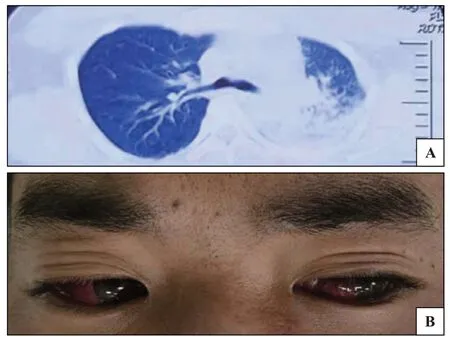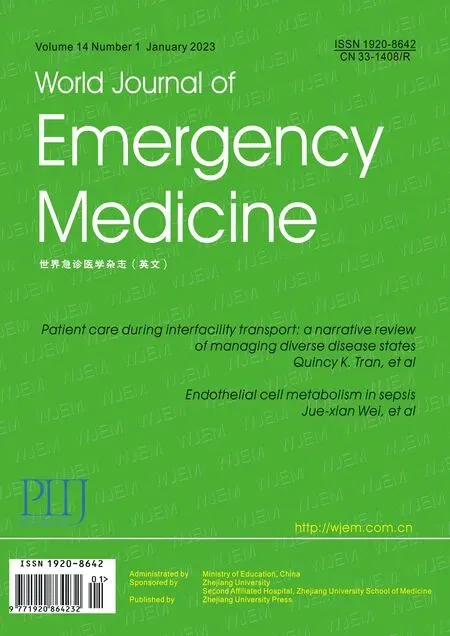A case of chemical eye injuries and aspiration pneumonia caused by occupational acute chemical poisoning
2023-02-07LiwenZhaoLongkeShiYaqianLiZixinWenPingHanXiangdongJian
Li-wen Zhao, Long-ke Shi, Ya-qian Li, Zi-xin Wen,3, Ping Han,4, Xiang-dong Jian
1 School of Public Health, Cheeloo College of Medicine, Shandong University, Jinan 250012, China
2 Department of Poisoning and Occupational Diseases, Emergency Medicine, Qilu Hospital, Cheeloo College of Medicine, Shandong University, Jinan 250012, China
3 School of Nursing and Rehabilitation, Cheeloo College of Medicine, Shandong University, Jinan 250012, China
4 Department of Emergency Medicine, Qilu Hospital, Cheeloo College of Medicine, Shandong University, Jinan 250012, China
Dear editor,
According to the China’s National Standard Diagnostic Criteria of Occupational Diseases, occupational acute chemical poisoning refers to the short-term exposure of workers to several chemicals during production, resulting in corresponding organ damage. Herein, we report a case of chemical eye injuries and aspiration pneumonia caused by acute chemical poisoning in the chemical industry.
CASE
The patient was a 21-year-old male with 3 months of work experience and no previously reported health issues. The patient carried out the acidification oil press process as part of his job. The acidification pool (3.0 m×3.5 m×3.0 m) at the factory contains a variety of animal, plant, crude, and acidification oils; methanol; sulfuric acid; gases derived from fatty acid waste; waste-water; etc., accounting for approximately one-third of the pool volume. All workers wore overalls, disposable masks, rubber gloves, and rubber shoes.
On November 10, 2021, at approximately 8 p.m., he fell into the acidification pool and became unconscious. He was in the pool for approximately 15 min. Firefighters retrieved him from the pool, and paramedics provided first aid. The patient was admitted to a local hospital 20-30 min later. On arrival, his temperature was undetectable, pulse was 100 beats/min, respiration was 24 breaths/min, and blood pressure was undetectable. The patient was in a coma. His eyes showed conjunctival congestion, with pale palpebral conjunctiva, burned conjunctival sac beneath the cornea of the right eye, transparent cornea, corneal defects above the left eye, and burned peripheral corneal epithelium; the anterior chambers of both eyes were clean; the diameter of both pupils was approximately 3 mm, and many foreign bodies could be observed in the eyes. The breathing sounds of both lungs were crude, audible, and alternating between slightly dry and wet.
After examination and laboratory tests, the primary diagnosis was organic solvent poisoning with burn injuries to the corneal conjunctiva. Computed tomography (CT) revealed aspiration/obstructive inflammation in both lungs (Figure 1A). Methylprednisolone sodium succinate (1,000 mg) and Xingnaojing (20 mL; Wuxi Jiyu Shanhe Pharmaceutical Co., Ltd., China) were administered intravenously, and erythromycin eye ointment (2 g) was applied. Hemoperfusion therapy, physiological saline rinsing of the conjunctival sac, and autogenous blood injection under the conjunctiva of both eyes were carried out.
The patient was admitted to our hospital on November 11, 2021, at 15:42 p.m. (18 h post-accident). On arrival, his body temperature was 38 ℃; his heart rate was 95 beats/min, his respiration rate was 21 breaths/min, and his blood oxygen saturation was 80%-85%. The patient was comatose, with shallow respiration, bilateral conjunctiva hyperemia and eyelid edema, and white discharge below the corner conjunctiva (Figure 1B). Both pupils were 3 mm in diameter and insensitive to light. Deep wet breath sounds were heard in both lungs. Heart rhythm was normal, abdomen was soft to touch, and pathological reflex was not induced. The patient was diagnosed with aspiration pneumonia, moderate occupational acute chemical poisoning,[1]and moderate eye burn injuries, according to the China’s National Standard Diagnostic Criteria of Occupational Diseases.

Figure 1. Lung computed tomography (CT) and eyes of the patient. A: lung CT performed on November 11, 2021, showing aspiration/obstructive infl ammation in both lungs; B: eyes of the patient after admission.
Betamethasone (10.52 mg) and imipenem (1.0 g) were administered intravenously with intramuscular injection of rat nerve growth factor (30 g). Other medications included pantoprazole (40 mg, intravenous drip, q12 h), torasemide (20 mg, intravenous drip, bid), ω-3 fish oil fat emulsion (100 mL, intravenous drip, qd), siverestat sodium (0.3 g, micropump pump, 2 mL/h), and Ringer’s solution (500 mL, intravenous drip, qd). Ofloxacin ointment and eye drops were administered, and the conjunctival sacs of both eyes were rinsed. On day 3, the patient was still comatose, with intermittent fever, hyperemia, edema in the conjunctiva of both eyes, and loud breath sounds in both lungs. The white blood cell count, lactate dehydrogenase, and creatine kinase levels remained higher than the reference ranges (supplementary Table 1). Chest CT revealed pneumonia in both lungs. On day 5, the patient was conscious with intermittent fever. Because of the increased level of interleukin 1B (21.4 pg/mL, reference range 0-5 pg/mL), hemoperfusion was performed using HA380 (Jafron Biomedical Co., Ltd, China). On day 7, the patient’s temperature returned to normal, congestive symptoms were slightly relieved, and vision was blurry. Brain magnetic resonance imaging showed no obvious abnormalities. Betamethasone and imipenem were stopped; ciprofl oxacin (0.4 g, intravenous drip, qd) and prednisone (30 mg, oral, qd) were prescribed. On day 14, the patient showed marked improvement with clear vision in both eyes. His condition improved, and he was discharged on November 27, 2021. At follow-up, he showed good recovery without sequelae.
DISCUSSION
C hemical eye injuries are an ophthalmic emergency and are responsible for 11.5%-22.1% of eye injuries,[1]and alkaline substances cause more serious injuries than acidic substances.[2]The clinical course of chemical eye injuries can be divided into immediate, acute, early, and late repair stages.[3]Conventional treatment focuses on promoting epithelialization, minimizing inflammation, and preventing cicatricial complications.[4]C hemical eye injuries can lead to severe vision loss despite active treatment.[5]In the present case, the patient had moderate eye burn injuries due to mucosal exposure to chemicals; he could not see clearly, and there was a high risk of blindness. Considering the high possibility of eye contact with acidic chemicals, short time in the pool, and timely treatment, he was administered subconjunctival injections of autogenous blood in both eyes along with ofloxacin eye ointment and eye drops; the conjunctival sacs of both eyes were rinsed.
Aspiration pneumonia is one of the most serious complications of partial consciousness or coma and is caused by chemicals or bacteria that originate from inhalation of food, oropharyngeal secretions, and stomach contents. Our patient accidentally inhaled the contents of the acidification pool, resulting in chemical pneumonia that eventually led to hypoxia, dyspnea, and fever. Because there is no specific treatment for such a condition, it is important to use antibiotics to control infection and maintain respiratory tract patency.
N otably, the substances that caused the poisoning were not identified; the eyes were not subjected to pH measurements, optometric examinations, or electroencephalography, because the patient was irritable and extremely uncooperative in the early stages of treatment.
CONCLUSION
We report a rare case of occupational acute chemical poisoning complicated with chemical eye burn injuries and aspiration pneumonia. No specific treatment plans for these injuries are proposed because of their sudden and varied nature. Therefore, antibiotics must be administered as soon as possible to control infection along with adequate eye care, neuronutrition, hemoperfusion, and other comprehensive symptomatic treatments.
Funding:None.
Ethical approval:T he patient provided verbal consent and agreed to the publication of this case report.
Confl icts of interest:There are no confl icts of interest.
Contributors:All authors contributed to the study conception and design. The first draft of the manuscript was written by LWZ; XDJ performed the final checks; material preparation and data collection and analysis were performed by LKS, ZXW, and YQL. All authors commented on previous versions of the manuscript. All authors read and approved the final manuscript.
All the supplementary files in this paper are available at http://wjem.com.cn.
杂志排行
World journal of emergency medicine的其它文章
- Modified qSOFA score based on parameters quickly available at bedside for better clinical practice
- Hyoscine N-butylbromide inhalation: they know, how about you?
- Occurrence of Boerhaave’s syndrome after diagnostic colonoscopy: what else can emergency physicians do?
- A case of unusual acquired factor V deficiency
- A case of persistent refractory hypoglycemia from polysubstance recreational drug use
- Cardiogenic shock and asphyxial cardiac arrest due to glutaric aciduria type II
